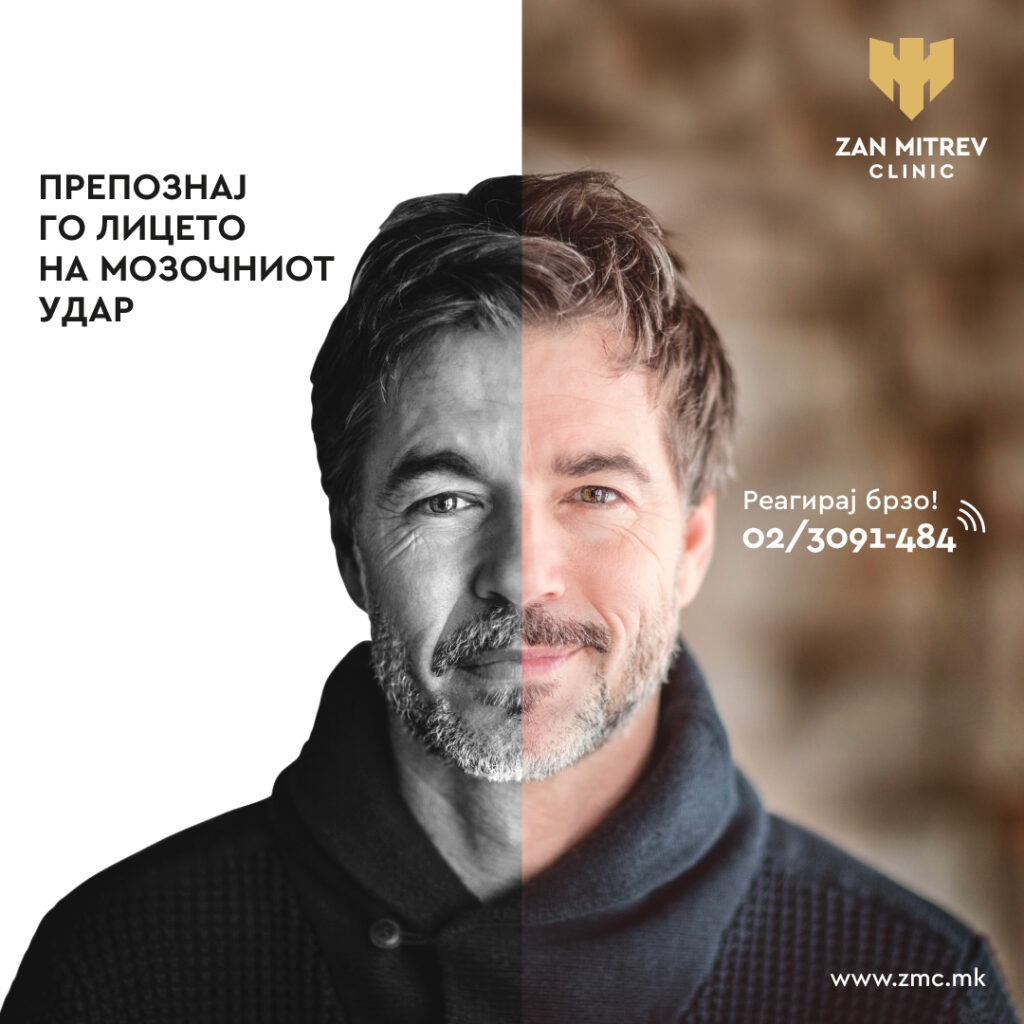Advice from "Zhan Mitrev" Clinic: Recognize the symptoms of a stroke and react "URGENTLY"!

According to the American Stroke Association, every four seconds a person experiences a stroke, and every 40 minutes a person dies from the same cause. The numbers are frightening!
Signs and symptoms of a stroke are as follows: slurred speech and impaired perception of the environment, confusion or sensory aphasia; paralysis or weakness of the face, arms or legs. This often happens only on one side of the body, and can also cause lip asymmetry; vision problems in one or both eyes, reduced vision or dark spots in one or both eyes, or double vision; headache – sudden severe headache, which is often accompanied by vomiting, dizziness or impaired consciousness; Difficulty walking – ataxia, loss of coordination or sudden weakness.
How to recognize a stroke?
A stroke can manifest itself in several different ways. In milder forms, a stroke can lead to symptoms such as: paralysis of one half of the body and face, difficulty speaking, difficulty swallowing, difficulty breathing, loss of vision, inability to recognize faces and complete loss of speech. Certain cases of severe drowsiness and even coma can also be observed. In its most severe form, a stroke can cause instant death. At the appearance of any of these symptoms, it is necessary to go to the doctor immediately, to do quick necessary investigations, which include Doppler echography and of course computed tomography with angiography of the carotid arteries. In order to have better success in the treatment, it is necessary to complete the investigations within the first 6 to 12 hours.
Performing the operation
Surgical treatment is used in chronic forms of previous strokes with atherosclerosis of the carotid bifurcation, and of course in acute forms of stroke. With the surgical treatment, the atherosclerotic plaque (deposit) is removed from the carotid bifurcation and from the internal carotid artery, which directly supplies blood to the corresponding side of the brain. Atherosclerotic plaques (plaques) can be calcifying, mixed and the most dangerous so-called soft plaques, which carry a high risk for the most severe form of stroke. In the latter type, there is an indication of faster intervention, even for smaller narrowings of the internal carotid artery, which are detected during computerized angiography. Operative access to the carotid bifurcation on the left or right side of the neck is planned depending on the findings of the computed angiography. The surgical incision is about 2 centimeters in size, placed in accordance with the folds of the neck, so that after the healing of the wound, it will be invisible, that is, it will be hidden in the folds of the neck.
Advantages of minimally invasive surgical treatment
Not only is the surgical incision minimally invasive. A minimally invasive approach is also used in anesthesia. The operative intervention is performed under block anesthesia or so-called local anesthesia, by administering an anesthetic directly to the area of operative intervention, without using general endotracheal anesthesia. There are several advantages to using this local anesthetic. By avoiding general anesthesia, the use of many drugs, intubation and mechanical ventilation is avoided. There is no long awakening in intensive care with the possibility of hemodynamic destabilization. All the complications associated with them are also avoided. The length of stay in the hospital is also shortened. If the operation is performed in the morning and the patient is stable, he can be discharged home the same evening. During the operative procedure, the patient is awake and communicates with the doctors and nurses, thus during the operative intervention, neurological monitoring is done to see if everything is in order and the end result is clear. Neurological assessment is impossible to perform in a sedated patient under general anesthesia. He can be evaluated neurologically only after he wakes up, after a few hours have passed since the operative intervention was completed. If, after the operative intervention under general anesthesia, a neurological deficit is determined, it is necessary to intervene again, and it is possible that the so-called golden time for intervention, i.e. the time frame in which the damaged brain tissue can be saved, has passed.
This new minimally invasive approach to the treatment of carotid atherosclerosis provides another advantage: the healing period in these patients is much shorter. This means that they can return to their daily functioning much faster. There is no need for wound control or suture removal as they are not used in wound closure. The wound can be showered the next day.
This minimally invasive approach to the treatment of atherosclerosis of the carotid arteries is applied as a routine procedure at the "Zhan Mitrev" Clinic. So far, more than 5.000 patients have been operated on in this way, with excellent results. For information contact tel. 02/3091-484.


